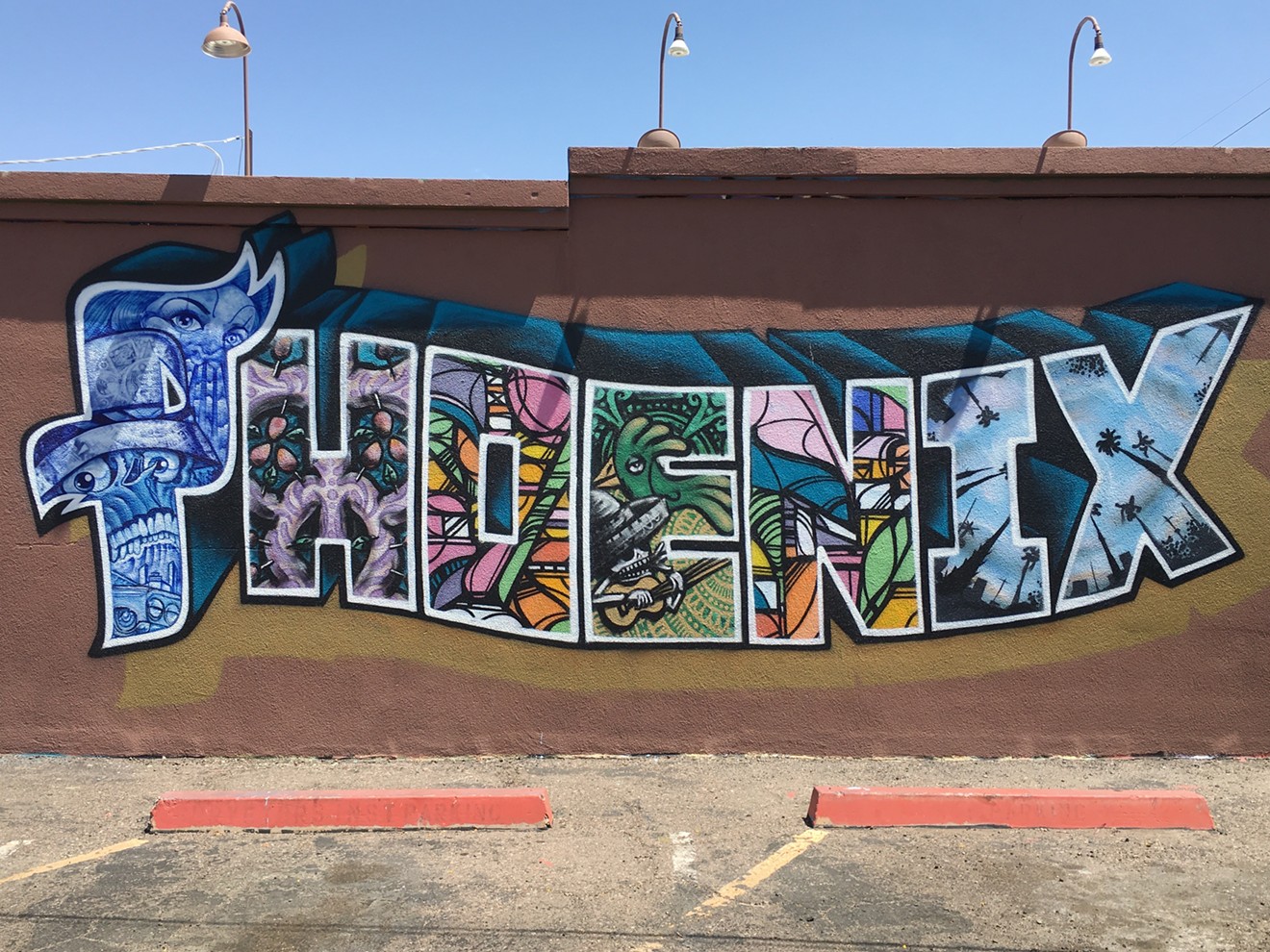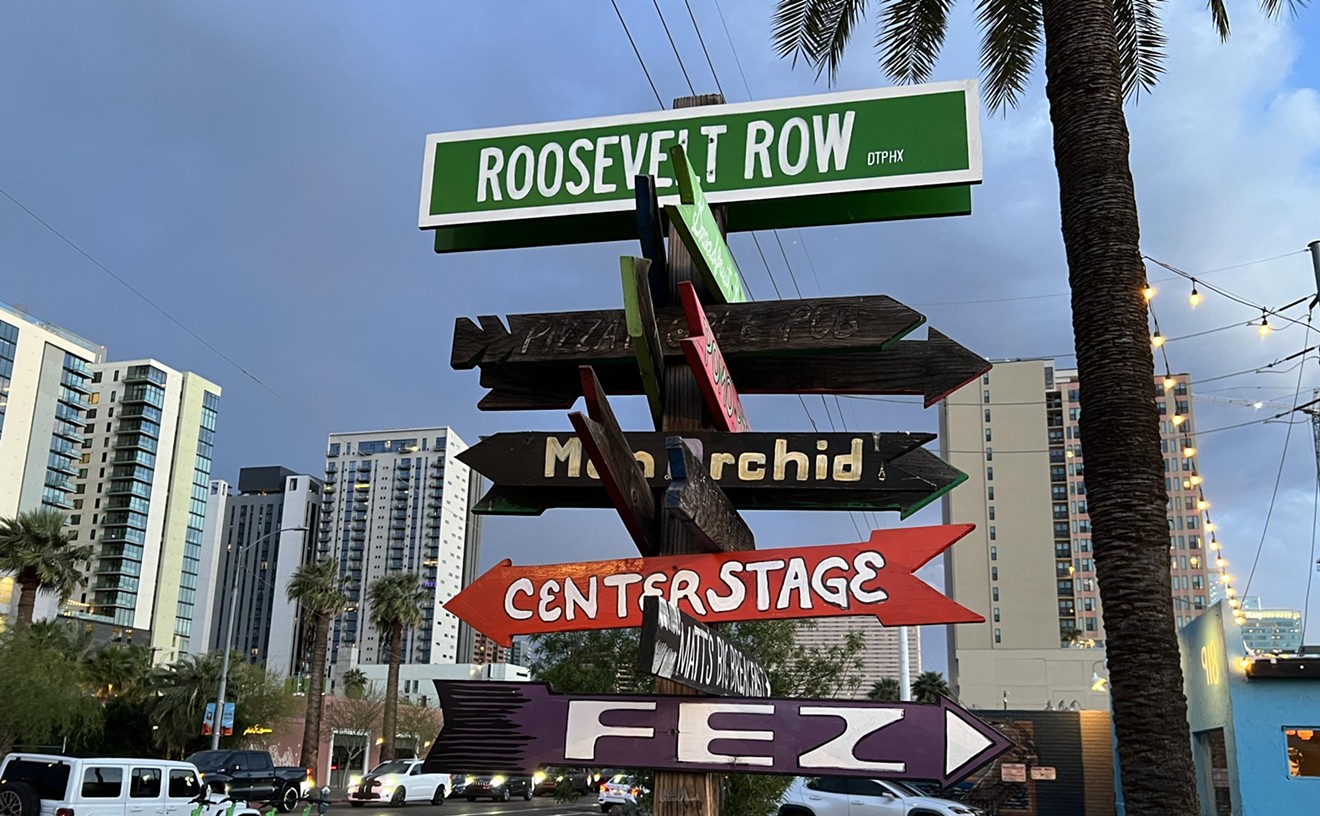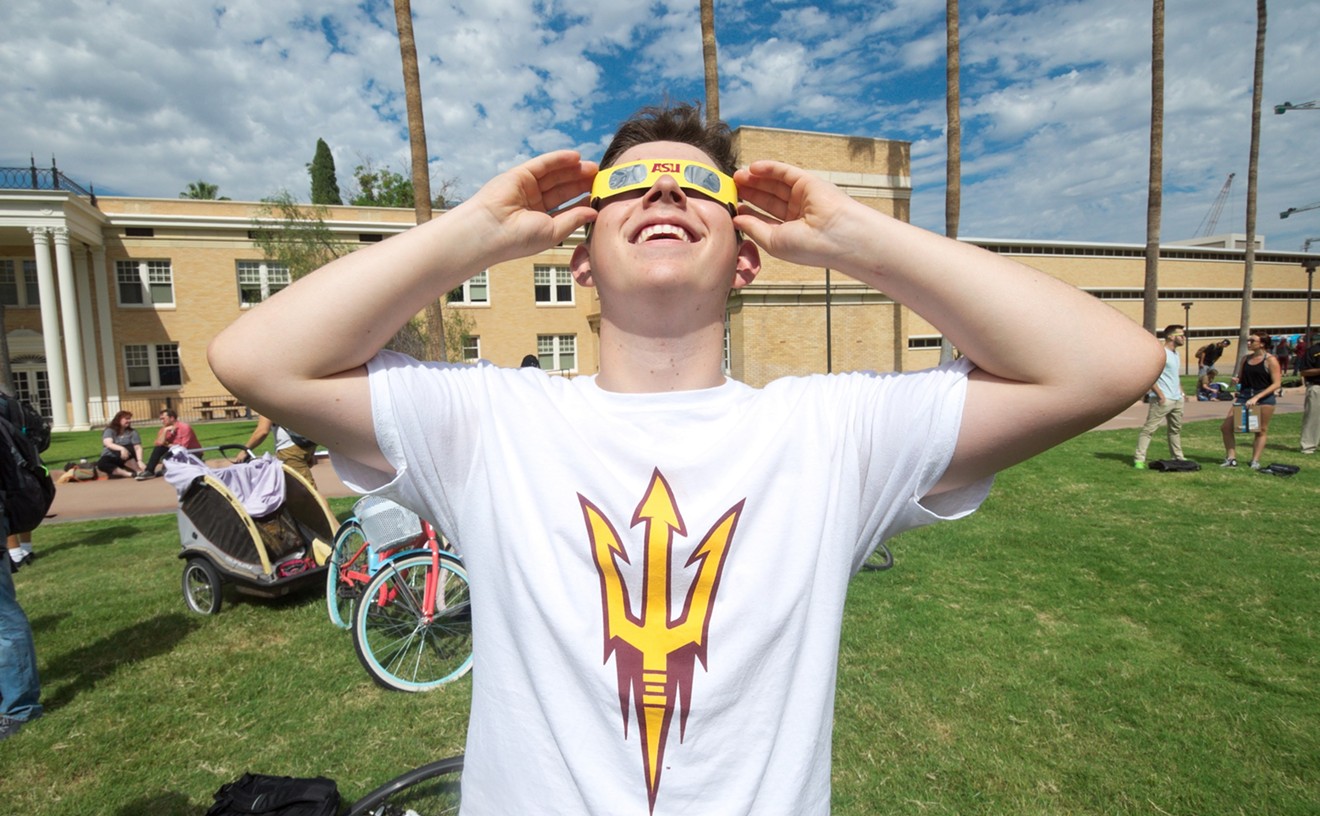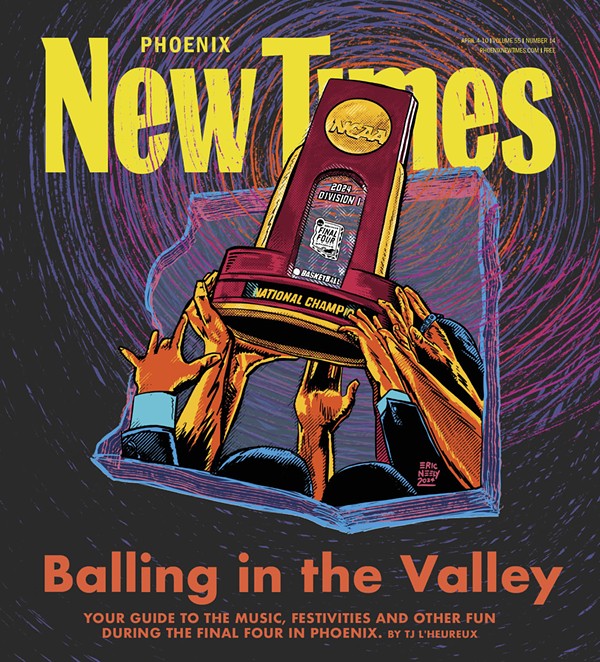Phoenix soon could be home to a new Latino Cultural Center.
Since 2016, the City’s Office of Arts and Culture has been working with Los Angeles-based consultant Evonne Gallardo to help develop a plan.
Earlier this spring, the City held three town halls to gather input about what people might like to see in a new Latino Cultural Center. More than 150 people, including several Valley-based Latino artists, attended. Gallardo is gathering additional input by interviewing stakeholders and reviewing results of a related survey the City of Phoenix currently has online.
Anyone can fill out a survey to formally submit their opinions about the possible Center. It's open online through Friday, May 26. In June, Gallardo will submit a report to the City about her findings and recommendations. The soonest a specific plan could go to the City Council for possible approval is September, says Gail Browne, executive director for the City of Phoenix Office of Arts and Culture.
Working with Vice Mayor Laura Pastor and City Council member Michael Nowakowski, Gallardo also put together an advisory board.
Advisory board members include Jose Antonio Aguayo, G.G. George, Martha Gil, Jose Andres Giron, Carmen Guerrero, Casandra Hernandez, Johnny Lazoya, Daniel Martinez, Gabriela Muñoz, Carlos Rascon, Guillermo Reyes, Alberto Rios, Albert Santana, Mary Stephens, Erlinda Torres, and Laura Wilde.
Many say the Center is long overdue — for two reasons.
First, one in four Phoenix residents are Latino, per City records.
And second, because a City bond program in 2001 slated $1.4 million for promoting knowledge and appreciation of Latino culture. At this point, the City has approved allotting $1.1 million towards creating a new Latino Arts and Cultural Center.
It's happening now because Pastor and Nowakowski are excited about moving the project forward, Browne says.
Originally, the City planned to use those funds for a small museum called Museo Chicano, says Browne. That project fell through in 2009, she says. The City now leases the former Museo Chicano space to a nonprofit called Arizona Latino Arts and Cultural Center.
It's one of several Valley-based organizations and initiatives already focusing on Latino arts and culture. Others include CALA Alliance, ASU's Performance in the Borderlands, Cultural Coalition, Sagrado Galleria, and Xico Arte y Cultura.
But some artists think something different, or something more, is needed.
New Times reached out to local creatives and asked them to weigh in. We had one question for them: What do you think of City of Phoenix efforts to create a new Latino Cultural Center?
In some cases, the artists we contacted hadn't yet heard about the City's outreach on the subject. Taken together, the responses we received offer a glimpse at past efforts to support a diverse and passionate Latino arts community. Whether and how City officials move forward with creating a Latino Cultural Center remains to be seen.
Here’s a look at what some of the creatives New Times surveyed had to say. Responses have been edited for clarity and length.
Jim Covarrubias
Founder, Movimeinto Artistico de Rio Salado; Member, Alliance for Latino Arts and Culture
The proposed Phoenix Latino Cultural Center would represent 40-plus percent of the population residing in Maricopa County, this fact alone seems substantial enough to warrant a center serving and sharing the centuries old Latino/Native American culture of the Southwest. The programs and services of this cultural center would present and develop an appreciation for Latino culture; art, performance and traditional music, which enhance visibility and sharing. The study and documentation of this community certainly should be engaged as precious historical information has already been lost or destroyed due to the city's growth and development. In essence, we will share this dynamic culture in a more formal and disciplined manner.
The center would rely on components already active and productive in the Latin community and develop new programs answering the continued growth and assets of this culture. A great percentage of this community is young and deserves the attention of developing their understanding of their history and culture. Talented students of all ages should be able to hone latent skills in the arts through Masters in the Latino community. In essence this center would be a very active asset for Phoenix and enhance the other great centers of culture of which we are so proud. It’s time for the Latino community to be included in the major arts institutions for their merit and their history.
Casandra Hernández Faham
Curator/Curaduría y Dirección, CALA Alliance
I am excited by efforts by the City of Phoenix to create a new Latinx Cultural Center. We need more spaces for Latinx public culture in a city that is 40 percent Latinx. We need places that reflect and negotiate the culture that is being produced at this time and place, and that embrace the diversity and complexity in its meaning. I believe cultural work is vital to our sense of belonging and participation in the urgent questions of our time. Art and culture are ways of investigating and knowing, of coming together in our differences, and of thrusting the collective imagination forward. I hope this new Latinx cultural space will be a place to test new ideas and construct empowering and liberating narratives for Latinxs in our city.
James Garcia
Playwright
As a playwright who mostly creates Latino and multicultural works, the idea that Phoenix may finally have a space where Latino-themed plays are expected and not out of the norm thrills me. As a sometime ethnic studies professor, I know well the history and experience of second-class citizenship Latinos have had, despite our presence in this region for more than 300 years. A facility like this is long overdue, especially given the cultural, social, and economic contributions that have been made by Latinos over the course of history. As a citizen and advocate for the arts I understand that as much as I believe compelling stories about Latinos have been ignored or repressed for far too long, I also know our entire community is enriched when we get to hear everyone’s story and not just those of a privileged few.
For me, it’s almost as important that non-Latinos see my work as Latinos. That’s why a Latino cultural center needs to be inclusive of non-Latinos in the same way that we’ve insisted other arts spaces include us. More bluntly, if white people don’t feel welcome, then we’ve only won half the battle. Finally, there is strong economic argument to make in favor of a Latino cultural center. Latinos spend about $45 billion a year in goods and services in Arizona. In Maricopa County alone, they spend $200 million or more on arts and culture every year – a number that will continue to rise as Phoenix Latinos reach majority status in the population. It makes good economic sense to tap and cultivate Latino spending on arts and culture for the sake of the economy and, yes, because, “It’s about time!”
Liliana Gomez
Choreographer/Dancer
2.1 million Hispanics reside in Arizona. A Latino Cultural Center would benefit this thriving community. I hope this Center offers greater exposure to Arizona artists, and that it is accessible for all. I hope the City of Phoenix and the Center, in collaboration with the existing Arizona Latino Arts and Cultural Center, affords opportunities for Latino artists who wish to create artwork in Phoenix.
As a Latina artist, I among many others would benefit from such a Center — a center that welcomes both my ideas and the color of my skin. This space could offer many services and resources: from community dance classes for young children of color, to studio facilities for artists to create magnificent work in Arizona. I appreciate the City's efforts to involve the community in the development of a Latino Cultural Center. The town halls, one-on-one artist meetings, and the community teams it created to receive feedback all successfully gave a voice to the community's thoughts on the matter.
Carmen Guerrero
Executive Director, Cultural Coalition
It is a wonderful idea! The thought is very attractive and compelling. However, the question is, "Why now?" The City of Phoenix has been sitting on this bond funding for over a decade. So what is different now? What will $1 million buy? Will it be an amazing new place? How much is the City of Phoenix willing to commit beyond this initial investment? How many more millions have to be raised, especially at a time of adversity against Latinos nationwide? After 40 years of local arts activism in the Chicano community, we learned to be a virtual cultural organization. We have created grassroots arts programs that serve our community by offering culturally relevant programmatic activities to schools, community centers, parks and libraries. We make use of public facilities and take art to the people.
Yes, it would be great to have a cultural center where we can gather and share the artistic vibrancy and rich cultural diversity that is the Valley of the Sun. It has the potential to project Phoenix to a higher standard that would serve to recognize and acknowledge the ever-growing demographics. This is a conversation that needs to continue! What we really need is the funding. Why not finance the already effective arts organizations that are cultivating culture in our city’s facilities right now?
Annie Lopez
Artist
I have thought about this issue for a couple of weeks now. At first, I was thrilled. Then I remembered the hours and hours of meetings spent downtown (2005-6?) talking about the fate of Museo Chicano with a group of Latinos active in the art scene at the time. That failing museum was going to be the location of our new cultural center. It would be a space dedicated to art and music and spoken word and all Latinos would be welcome to use the space for their artistic endeavors. That was exciting. I was one of the first to write a check for membership dues. Then the first exhibit happened, and someone tried to purchase my work, and I learned there was no one in charge. Yes, there was a director, but no leadership. I distanced myself from the group. My name was used in publicity for exhibits I was not invited to. The place turned back into what we wanted to replace.
So, when I heard about a new cultural center, I thought about participating in discussions. However, since people who are involved in that other space are included in these discussions, I stayed away. Who would decide what is represented there? I only heard about the center by accident, anyway. I would love to be involved, providing the right people are included and the intentions are acceptable. The center should be for all Latinos and everyone wishing to share in Latino culture.
Rosaura “Rosie” Magaña
Founder and Owner, Palabras Bilingual Bookstore
I think a Latino cultural center is important for proper cultural representation. My concern is that it will go the way of other institutions and let the organizations and individuals who fund it hold the final say on the art and activities taking place there. I feel as though very relevant issues and topics are sugar-coated or simply not addressed at all because of the need to appease those funding the project, because well, sometimes those very organizations are part of the problem. When this happens all these "cultural centers" do is reinforce the submissive and subservient roles that have caused Latinos to be marginalized in the first place while making organizations and individuals who could care less look as though they are doing a good deed. If that's what is happening here, I do not want it in Phoenix. We have enough of that already.
If the cultural center is going to be run by the Latino community with efforts to involve ALL community members, even those without internet access, then yes I would encourage and support it. Simply said, we do NOT need people who are not Latino running a Latino cultural center or hosting Latino events. There are plenty of capable and experienced Latinos in our community and it is an insult to have someone who is not Latino running our cultural center. With all of that said, I hold out hope that the City of Phoenix creates a cultural center that accurately reflects its community, which I believe is critical to empowering the Latino community of Phoenix.
Julio Cesar Morales
Chief Curator, ASU Art Museum
Cultural centers are always needed and a necessary measure to bring insight and understanding of other cultures outside our social norm. Examples of successful cultural centers are Galeria de La Raza (oldest Latino nonprofit art center in the U.S.) in San Francisco and Asia Society in New York, which both show important and socially relevant art exhibitions and thoughtful public programs connecting communities through art. These centers bring new discourses that preserve cultural past traditions while working with artists to address current social justice issues relevant to their communities.
One can think about this new Latino Cultural Center in Phoenix as Trump’s desire to build a new wall. Has no one has told him that about 10 years ago a new wall was erected to the tune of about $8 billion? The Arizona Latino Arts Cultural Center (ALAC) in downtown Phoenix is the mirror of the existing border wall — in prime real estate in downtown Phoenix, this cultural center was the promise to “celebrate, and promote Latinos in Arizona through education, advocacy, and collaboration,” but for the last five years since I have been here, it has not lived up to its potential. Phoenix desperately needs a new Latino Cultural Center to represent its roots, immediate reality, and potential future. We have to dream that it is possible to have a cultural center that serves the Latino community and creates stronger ties to our larger desert culture in promoting unity through cultural heritage and the power of contemporary art.
Mary Stephens
Producing Director, Performance in the Borderlands (ASU)
Phoenix has one of the largest populations of Latino residents, and it is long overdue that the City supports this cultural representation. The vast cultural and intellectual contributions of Latino residents make me proud to live in Phoenix. It is long overdue that we hold our city officials accountable to take public action of financial and material support for a center of this kind.
Roy Wasson Valle
Artist
I welcome the possibility of a cultural center, and I think one that caters to the Latino perspective is necessary. The best element about a cultural center is that it is an inviting place for people outside the group to be introduced and build a relationship with those from another point of view and background. I would welcome a Latino Cultural Center that may provide a place of dialogue, learning, and enjoyment for all visitors. These are very isolating times for many, and the more understanding we have with one another the better our collective future may be.
Editor's note: This post has been updated from its original version to clarify that CALA Alliance is independent from ASU Art Museum
[
{
"name": "Air - MediumRectangle - Inline Content - Mobile Display Size",
"component": "18478561",
"insertPoint": "2",
"requiredCountToDisplay": "2"
},{
"name": "Editor Picks",
"component": "16759093",
"insertPoint": "4",
"requiredCountToDisplay": "1"
},{
"name": "Inline Links",
"component": "17980324",
"insertPoint": "8th",
"startingPoint": 8,
"requiredCountToDisplay": "7",
"maxInsertions": 25
},{
"name": "Air - MediumRectangle - Combo - Inline Content",
"component": "16759092",
"insertPoint": "8th",
"startingPoint": 8,
"requiredCountToDisplay": "7",
"maxInsertions": 25
},{
"name": "Inline Links",
"component": "17980324",
"insertPoint": "8th",
"startingPoint": 12,
"requiredCountToDisplay": "11",
"maxInsertions": 24
},{
"name": "Air - Leaderboard Tower - Combo - Inline Content",
"component": "16759094",
"insertPoint": "8th",
"startingPoint": 12,
"requiredCountToDisplay": "11",
"maxInsertions": 24
}
]






















